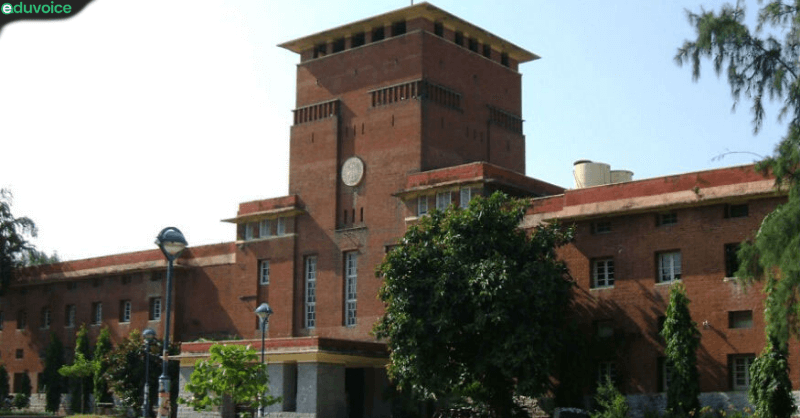Delhi University has released a draft undergraduate curriculum framework which has been formulated to orient its undergraduate programs towards the ethos of NEP-2020
Since the new National Education Policy (NEP-2020) has come into the picture, the debate has started. What would be the new structure of education for undergraduate students? Will it be for three years or four years? Will there be a rat race for 100 percent cut-off marks as was seen in the 2021-22 session, or is there a better alternative available?
Seven colleges of Delhi University had 100 percent cut-off in different disciplines in session 2021-22. There were a few more anomalies that surfaced; students from Kerala bagged most of the allotted seats in the best colleges of Delhi University. The reasons are simple. The state boards across India function differently. Some states are lenient, whereas others are tough in giving marks. Education falls under the Concurrent List. This also creates a dichotomy in the admission process for undergraduate students.
Newly-appointed Delhi University Vice-Chancellor (VC) Prof Yogesh Singh initially had a tough time. But he has come out with a few ideas that may change the grammar of higher education in India. Delhi University has the largest canvass for undergraduate students in India. Undoubtedly, it provides the best opportunities for undergraduate students. More than 5 lakh students are enrolled in hundreds of colleges. Therefore, the role of the VC becomes difficult, especially when different ideological factions and teachers’ groups are looking for opportune moments to target him. The new draft which was put in the public domain speaks volumes. It not merely resolves the rat race for admission but also assimilates NEP-2020. The new steps bring the DU to lead the universities in implementing NEP-2020, besides introducing revolutionary changes in the domain of higher education.
What are fundamental changes coming through this undergraduate curriculum framework, UGCF 2022? Delhi University released a draft undergraduate curriculum framework which has been formulated to orient its undergraduate programmes towards the ethos of NEP-2020. So far Indian higher education is unilinear. Science and Social Sciences and Humanities are segmented and separated. Quite often students of different blocks do not assimilate.
The unilinear approach brings alienation and an undesirable chasm on the campus and later in society. This draft allows students to opt for one, two, or more disciplines depending on their choice. It also allows the option of studying allied courses either from the selected disciplines or diversifying in other areas of study. There is an attempt of assimilation and creating a level-playing field. This will facilitate the holistic growth of students.
The second step is admission through an entrance test which would be providing much-awaited relief to students. The rat race for 100 percent is frustrating for lakhs of students. The VC has proposed admission through an entrance examination which will be conducted by National Test Agency, NTA. This step will also challenge the branding. Across mobility within the university would become possible through this scheme. As per NEP, students are also provided with academic mobility wherever they are enrolled for a program in college, but they can take up a course in a different college. Extending this facility will be easier for the university as it has more than 50 constituent colleges. For instance, a student pursuing economics in Ramjas College can take up a course in political science in Motilal College and a different course in Khalsa College. It is a unique mantra to kill the academic caste hierarchy in Delhi University.
The third major feature of the draft is enhancing the skill of research. Indian universities rank far behind in global ranking because of a lack of research. The draft duly acknowledged this fact and incorporated it as an important component in the fourth year of graduation. In the fourth year, students are provided the flexibility to opt for writing a dissertation or pursue academic projects or entrepreneurship depending upon their choice and their outlook. The research will enhance critical thinking among the students which is very important for society to grow.
Another feature is multiple entries and exit points which are an integral part of NEP-2020. Calling it a student-centric approach, Prof Yogesh Singh outlined that this is providing creative combinations of disciplines for study with multiple entries and exit points, providing ease to students to learn at their own pace. It is true India is diverse, economically and socially. Students come from diverse groups. Sometimes economic extremities do not allow a student to continue his/her second or third year in graduation. Therefore, his/her two years spent in college turned futile.
This draft proposal safeguards the interests of such students. Under the framework, a certificate will be awarded to students who complete one year in the college under any course. A diploma shall be awarded to students who exit at the end of the second year with 88 credits. Students will secure a bachelor’s degree with honors if they exit at the end of the third year with 132 credits. In the fourth year, students can either choose to pursue an honors degree in a particular discipline or an Honors degree with research with 176 credits.
Higher education in India is focused on producing disciplinary experts. But the new NEP proposes to break disciplinary boundaries. IIT-Bombay’s new Liberal Arts, Sciences, and Engineering (LASE) Programme is one example of how the NEP’s vision translates on the ground. The LASE program, which has been introduced this year, gives students the option to graduate with a Bachelor of Science (BS) degree in five fields or “concentrations” — engineering sciences, natural sciences, social sciences, art, and design. The fifth option permits the student to design his/her own concentration. LASE students will study a set of foundation courses in their second year such as modern South Asian history, history of science, contemporary digital societies, current social structures, reading and writing literature, in addition to their STEM courses.
Since DU has a large number of constituent colleges, it must take a lead role in implementing the NEP-2022. The new draft is designed to change the grammar of higher education in India. It is good that the DU VC has put the draft in the public domain to incorporate the views of different stakeholders.
For More Such Articles, News Update, Events, and Many More Click Here






